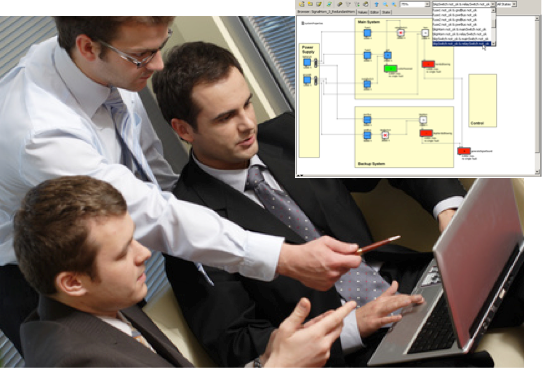 What are real „collaborative” tools in the system engineering process of complex systems? – Throughout today’s product development process there are a lot of typical islands of data, e.g. DOORS for Requirement Management, Visio for the Architecture drawings, Simulink for the analysis, FaultTree+ for Safety-/Risk-assessment, … and MS-Office to glue it all together. Independent of the benefit of such programs, if it comes to handover of produced results to the next team, there is usually a lot of effort required to read, understand and re-present (in the proper meaning of the word) them for the individual next analysis or procedure. Manual conversion costs time and quality.
What are real „collaborative” tools in the system engineering process of complex systems? – Throughout today’s product development process there are a lot of typical islands of data, e.g. DOORS for Requirement Management, Visio for the Architecture drawings, Simulink for the analysis, FaultTree+ for Safety-/Risk-assessment, … and MS-Office to glue it all together. Independent of the benefit of such programs, if it comes to handover of produced results to the next team, there is usually a lot of effort required to read, understand and re-present (in the proper meaning of the word) them for the individual next analysis or procedure. Manual conversion costs time and quality.
How can the process of system-, safety-, software- and also maintenance-engineering be streamlined by a really integrated solution? Which application cases exist and what are practical experiences? – This question was the motivation for a discussion started in march 2015 in several groups in LinkedIn, see below.
Such a platform should – maybe in individual views – ideally support the whole process from the bid phase over development, integration, testing down to operation and maintenance.
Here are some criteria that come to mind:
- central repository for easy knowledge storage and retrieval (for textual, tabular, graphical, binary data);
- allowing intuitive graphical definition of architectures over all levels and of hierarchical interfaces/ports;
- support for fault behavior description and analyses (e.g. FTA, FMEA, Diagnostics, …);
- allow definition of modular reusable building-blocks of various system-entities (libraries);
- capabilities/connections to quantitative/modelbased system analysis/simulation;
- providing version management/baselining;
- generation of tailored views and reports;
- good support for V&V and traceability;
- open interfaces to established tools;
- multi-user (of course) incl. definition of roles;
- web-based or standalone;
- applicable also for training purpose/maintenance instructions;
- …
The discussion has been started in the following LinkedIn-groups, bringing already a lot of very interesting comments:
- System of Systems Engineering (many comments)
- System Safety Professionals
- Service Lifecycle Management (SLM)
- Simulation Driven Engineering
Feel invited to these forums to learn about some very exciting tool and platform developments going on or to post your own ideas and thoughts.